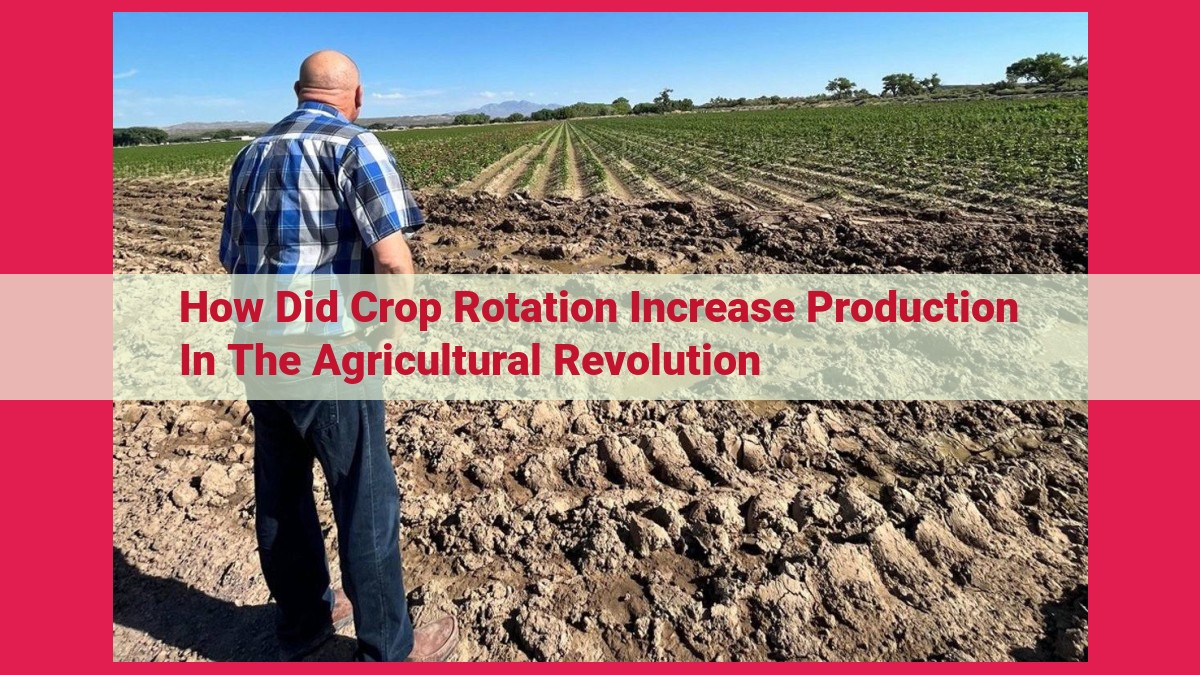Unlocking Agricultural Productivity: The Transformative Power Of Crop Rotation

Crop rotation revolutionized agricultural production by enhancing soil fertility through leguminous crops and nitrogen fixation. It optimized nutrient uptake, reduced pests and diseases, and improved soil structure. These benefits led to increased crop yields, food security, and sustainable agriculture.
Crop Rotation: The Unsung Hero of Agricultural Revolution
In the tapestry of human history, agriculture stands as a cornerstone of civilization. As our ancestors embarked on the arduous journey of cultivating the land, they stumbled upon a game-changing practice that would forever revolutionize food production: crop rotation.
This ancient technique involves alternating different crops in the same field over several seasons. It’s like a carefully choreographed dance, where each crop plays a unique role in maintaining the health and productivity of the soil.
Soil Fertility and Nutrient Management: A Symphony of Nature
Continuous cropping, where the same crop is grown year after year, can lead to nutrient depletion in the soil, akin to an orchestra playing the same melody without pause. Crop rotation, however, introduces diversity, allowing different crops to utilize specific nutrients, thus preventing soil degradation.
Leguminous crops, such as beans and peas, are nature’s nitrogen-fixing factories. They harbor beneficial bacteria that convert atmospheric nitrogen into a usable form for plants. This symbiosis enriches the soil, boosting overall fertility.
Enhanced Yield and Resilience: A Thriving Ecosystem
Like a well-balanced diet for the soil, crop rotation improves crop yields by diversifying nutrient uptake. Different crops have varying root depths and nutrient requirements, maximizing the utilization of soil resources.
Crop diversification also disrupts the life cycles of pests and diseases, acting as a natural defense mechanism. By preventing the buildup of a single pest species, crop rotation reduces the need for chemical interventions, promoting a healthier and more sustainable agricultural system.
Moreover, crop rotation enhances soil structure and promotes root development. Different crops leave behind unique organic matter and root systems, which improve soil drainage, aeration, and water retention, creating an optimal environment for plant growth.
Crop Rotation: A Cornerstone of Agricultural Success:
- Definition: Explain the concept of crop rotation and its historical background.
- Benefits: Discuss the numerous advantages of crop rotation, such as soil fertility enhancement, pest and disease control, and yield improvement.
Crop Rotation: The Unsung Hero of Agricultural Triumph
In the tapestry of agricultural history, crop rotation stands as an unsung hero, its humble practice revolutionizing the production of food that sustains us all. This time-honored technique has empowered farmers with the wisdom to unlock the secrets of the soil, enhancing fertility, curbing pests, and boosting yields to feed a burgeoning global population.
At its core, crop rotation is the practice of alternating different crops in a specific sequence over time on the same plot of land. This deceptively simple method holds a treasure chest of benefits for agricultural endeavors.
Fertility’s Guardian: The Magic of Legumes
Continuous cropping relentlessly depletes soil nutrients, leading to a barren wasteland. But crop rotation comes to the rescue like a nurturing guardian, replenishing soil fertility through the magic of legumes. These unsung heroes have the remarkable ability to fix nitrogen from the atmosphere, enriching the soil with this essential nutrient that nourishes all plants. By including legumes such as soybeans, alfalfa, and clover in the rotation, farmers can dramatically boost soil fertility without relying on synthetic fertilizers, promoting a more sustainable and environmentally friendly agricultural system.
Pest and Disease Control: Nature’s Balancing Act
Crop diversification is a masterstroke in pest and disease management. By rotating different crops, farmers disrupt the life cycles of pests and diseases, thwarting their ability to gain a foothold. Moreover, certain crops exude chemicals that repel pests or suppress disease. For instance, planting marigolds alongside tomatoes acts as a natural pest deterrent, while mustard has been shown to reduce the severity of fungal diseases. By harnessing the power of nature’s own defenses, crop rotation empowers farmers to reduce reliance on pesticides, fostering a healthier ecosystem.
Yields Soaring: The Symphony of Soil and Crop
Crop rotation is a symphony of soil and crop, working in harmony to maximize yields. By diversifying nutrient uptake, reducing competition for water and sunlight, and improving soil structure, crop rotation creates an environment where plants can thrive. Root development is enhanced, allowing plants to anchor themselves firmly in the soil and access deeper moisture and nutrients. Water retention is also improved, ensuring plants have access to the life-giving resource even during periods of drought. The result: bountiful harvests that fill our plates and nourish our bodies.
**Soil Fertility and Nutrient Management: The Foundation of Crop Rotation**
Continuous cropping, where the same crop is grown repeatedly in the same field, can lead to a significant depletion of soil nutrients, diminishing its fertility and productivity. Over time, the soil becomes exhausted as essential nutrients are removed by the crops, leaving it depleted and unable to support healthy plant growth.
This ongoing nutrient depletion can result in soil degradation, characterized by poor soil structure, reduced water retention capacity, and decreased organic matter content. The soil becomes more susceptible to erosion, further exacerbating the problem.
To address this challenge, crop rotation emerged as a revolutionary technique that revolutionized agricultural production. By alternating different crops on the same land, it conserves soil nutrients and enhances soil fertility.
Leguminous Crops: Nature’s Nitrogen Fixers
In particular, leguminous crops, such as beans, peas, and alfalfa, play a vital role in crop rotation. These plants have a unique ability to form symbiotic relationships with soil bacteria known as rhizobia. These bacteria form nodules on the roots of the leguminous plants, where they convert atmospheric nitrogen into a plant-available form.
This process, known as nitrogen fixation, enriches the soil with essential nitrogen that can be utilized by other crops in the rotation. Thus, leguminous crops serve as natural fertilizers, reducing the need for synthetic nitrogen inputs and promoting sustainable soil management.
By incorporating leguminous crops into crop rotation, farmers can replenish soil nitrogen levels, enhance soil fertility, and reduce their reliance on external fertilizers. This cycle of nutrient replenishment and revitalization is crucial for maintaining long-term soil health and crop productivity.
Enhanced Yield and Resilience: The Power of Crop Rotation
Yield Improvement: Unlocking the Potential of Diversification
Crop rotation, a cornerstone of agriculture, has revolutionized farming practices, leading to drastic improvements in crop yields. By diversifying nutrient uptake, reducing competition, and enhancing soil structure, crop rotation unlocks the potential of our land to produce more food.
As different plants have varying nutrient needs, rotating crops ensures that the soil is not depleted of any particular nutrient. Each crop draws on a specific profile of nutrients, replenishing the soil with different nutrients in the process. This balanced approach helps maintain soil fertility and maximizes crop yields.
Moreover, by alternating crops with different root structures and growth habits, competition for resources is reduced. Deep-rooted plants, like alfalfa, break up compacted soil and access deeper water sources, creating a more favorable environment for shallow-rooted crops that follow. This diversification in plant types promotes healthy growth and ultimately increases yields.
Reduced Pests and Diseases: Breaking the Cycle
Crop diversification, a hallmark of crop rotation, plays a pivotal role in controlling pests and diseases. Pests and diseases thrive in monocultures, where the same crop is grown year after year. By rotating crops, farmers disrupt the life cycles of these detrimental organisms, reducing their impact on crop health.
For instance, certain pests that attack corn may not be attracted to soybeans. By alternating corn with soybeans in a rotation, farmers can significantly reduce the incidence of these pests. Similarly, diseases that attack specific crops can be effectively controlled by rotating to non-host crops.
Enhanced Soil Structure and Root Development: The Foundation of Thriving Crops
Crop rotation profoundly influences soil structure, creating a healthier environment for root development and overall plant growth. Different crops have varying effects on soil structure. Some, like grasses, create a dense root network that holds the soil together, improving water retention and preventing erosion. Legumes, on the other hand, fix nitrogen in the soil, enriching it for subsequent crops.
By alternating crops with different soil structure requirements, farmers can maintain a well-balanced soil ecosystem. This improved soil structure supports healthy root development, enabling plants to access more nutrients and water, ultimately leading to increased yields and resilience against environmental stresses.
Legacy of Crop Rotation: A Cornerstone of Sustainable Agriculture
Crop rotation, a practice that alternates different crops grown in the same area over time, has revolutionized agricultural production. Its roots can be traced back to ancient times, when farmers observed the benefits of diversifying their crops.
Contributions to the Agricultural Revolution
Crop rotation played a pivotal role in the agricultural revolution by significantly increasing productivity and ensuring food security. By preventing soil depletion and reducing pests and diseases, it allowed farmers to cultivate larger areas of land and produce greater yields. This increase in food production led to population growth and the development of settled societies.
By providing an ideal environment for plant growth, crop rotation allowed farmers to maximize crop yields and create a more stable and reliable food supply.
Sustainable Agriculture and Food Security
In modern agriculture, crop rotation remains indispensable for sustainable food production and environmental preservation. The practice promotes soil health by preventing erosion, maintaining nutrient balance, and increasing organic matter. Moreover, by diversifying plant species and interrupting pest and disease cycles, crop rotation enhances ecosystem resilience and reduces chemical inputs.
As the world population continues to grow, the importance of crop rotation in meeting the increasing demand for food cannot be overstated. It is a practice that ensures food production is sustainable, environmentally friendly, and adaptable to changing conditions.




